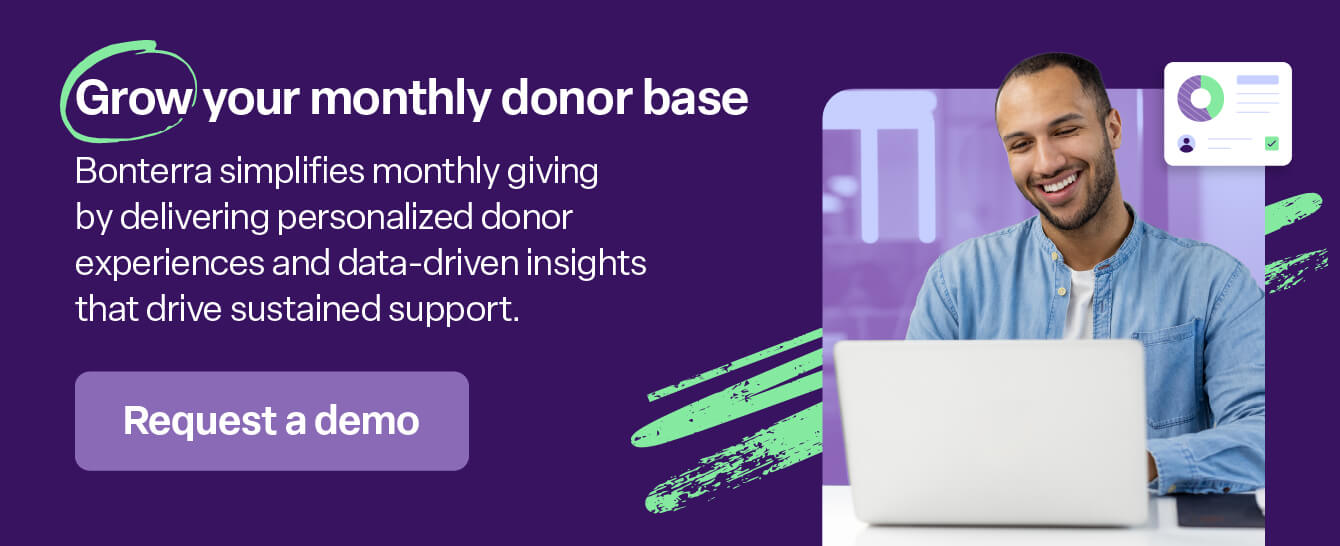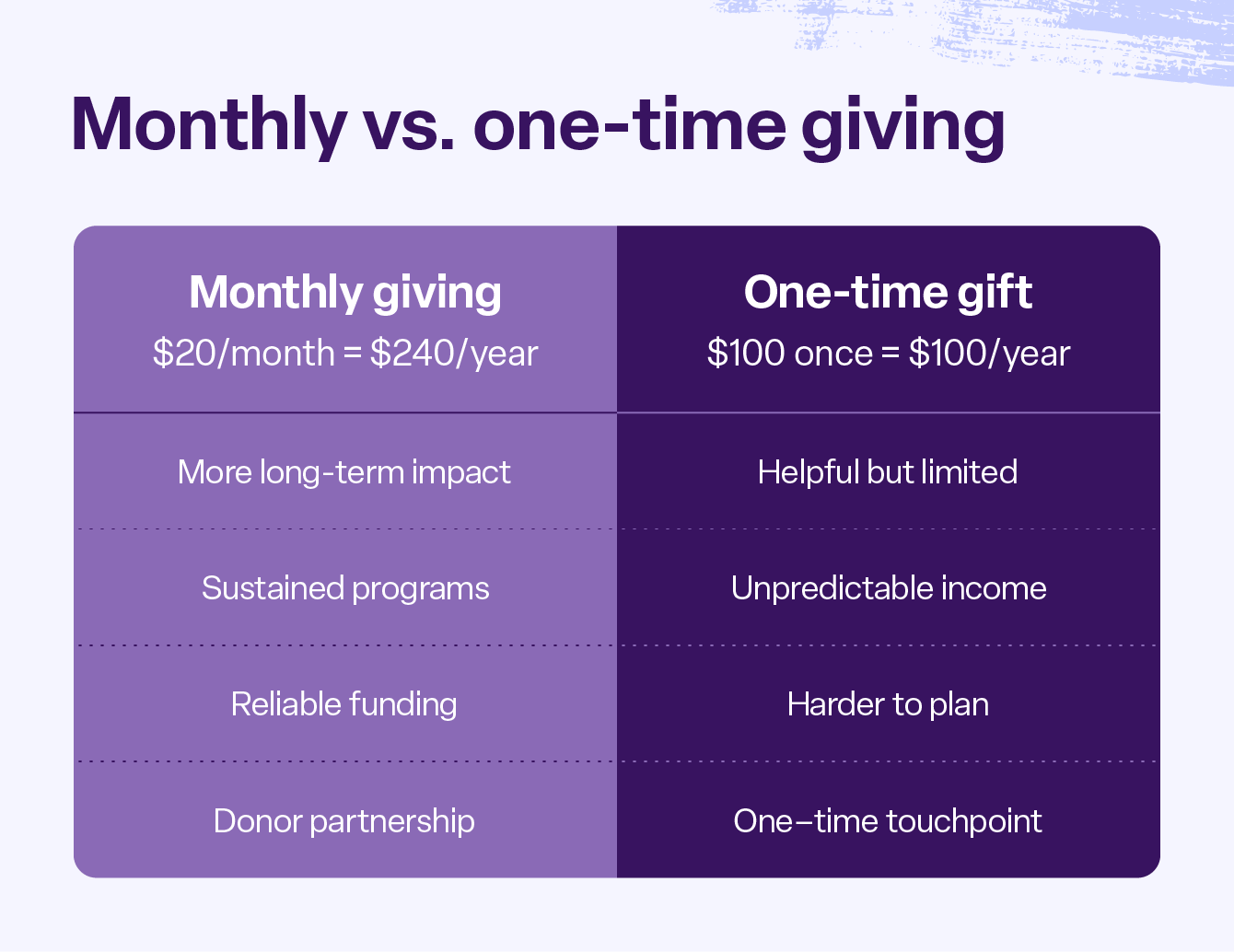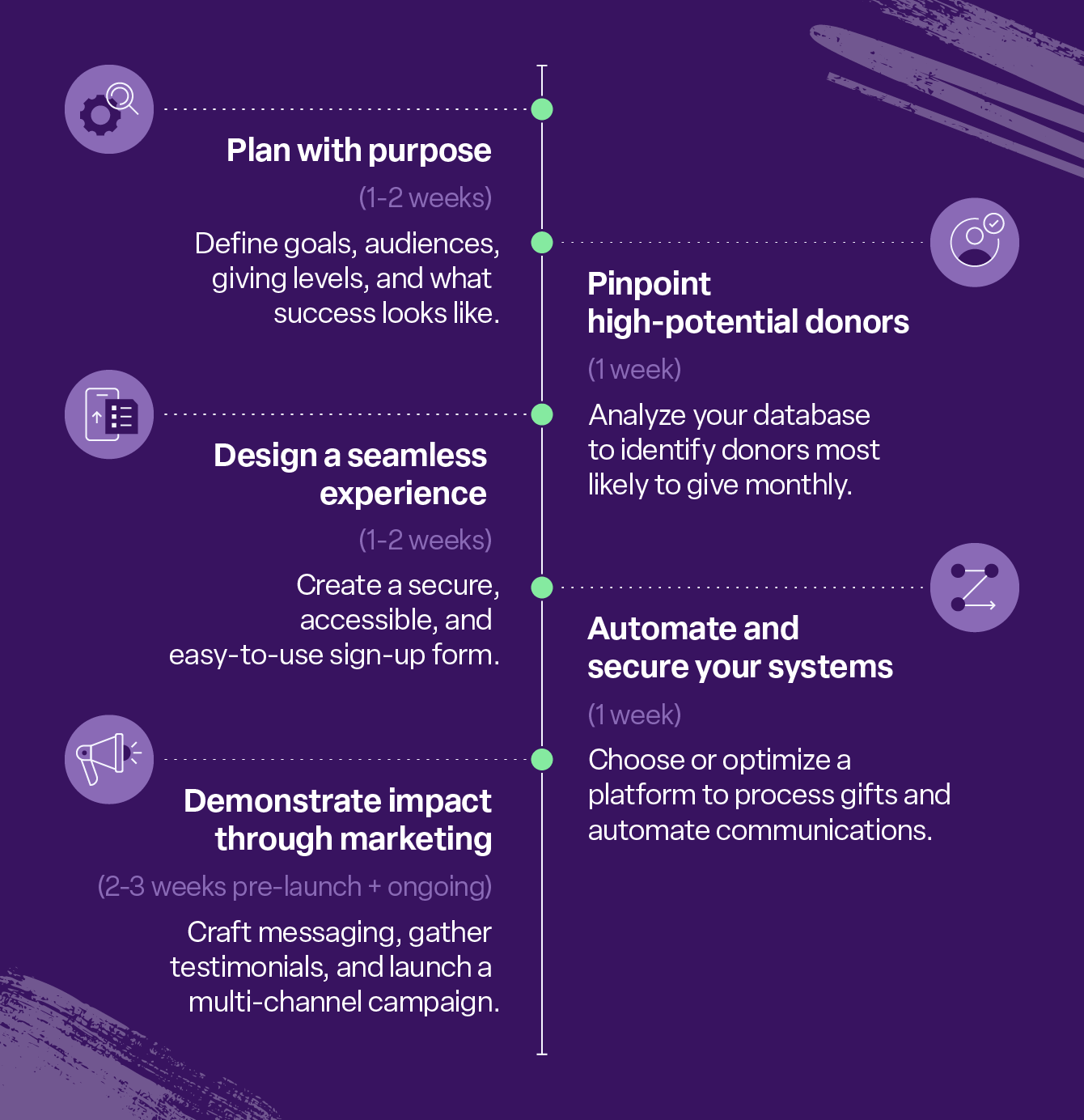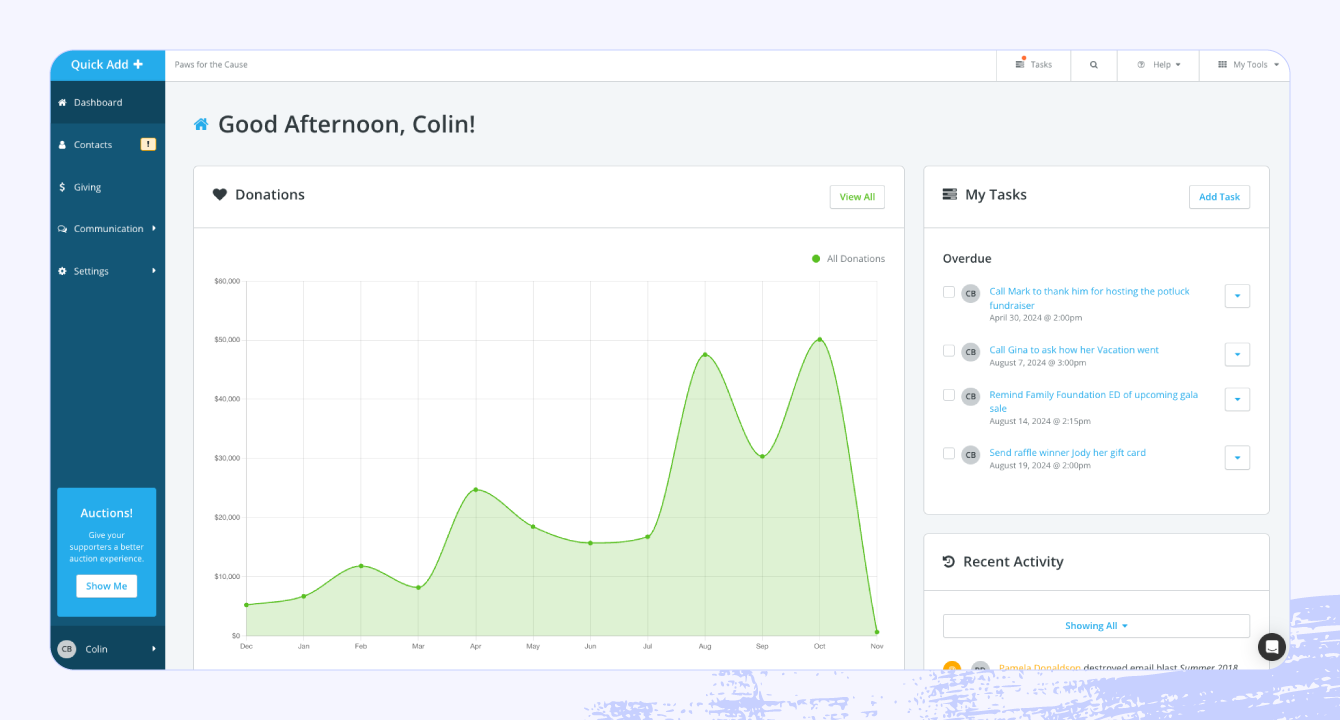Monthly giving: How to create a successful program for nonprofits

In recent years, nonprofit supporters have increased their recurring gifts to organizations, particularly monthly giving, which is a recurring donation sent monthly, often automatically.
Monthly giving isn’t just a convenient, set-it-and-forget-it way for donors to show their support; it’s also highly beneficial to the organization. In fact, data gathered for Bonterra’s recurring donations guide shows that donors who set up recurring donations donate 42% more in a year than those who engage in one-at-a-time gifts.
Keep reading to learn the benefits of monthly giving and how to start your own program.

Benefits of monthly giving for nonprofits
There’s a lot to like about monthly giving, for organizations and donors alike. It adds convenience to the donation process and leads to more predictable revenue, higher donor retention and engagement, and cost savings.

Predictable income
Monthly gifts provide an organization with a steady stream of income, helping reduce reliance on the seasonal peaks and valleys of giving. With a strong monthly giving setup, you won’t need to scramble to increase funds during historically low times.
Even if you end up with the same dollar amount at the end of the year, it’s easier to plan and predict your finances when you know you’ve got a specific amount coming in each month. This lets you better facilitate budgeting and planning and determine how you can best serve your mission.
Increased revenue potential
As a donor, smaller donations throughout the year can feel like less of a hardship than a single lump sum all at once, so monthly donors often give more over time than one-time donors.
For instance, a donor may plan to give $100 to their organization of choice. If they’re given the option of setting up monthly payments instead, paying $20 per month might feel more doable — which comes to a total of $240 for the year.
Improved donor retention
Donor retention can also improve with monthly giving. Because setting up a recurring donation is a way of entering into a longer-term relationship with your organization, donors may be more likely to remain with you for the long run.
Plus, rather than making a single donation and then moving on, donors with recurring gifts will constantly have your organization at the top of their minds — even more so if you can send them thanks and updates that show exactly where their donations are going.
Cost-effective fundraising
Letting donors set up monthly giving is also cost-effective as a fundraising tool. Monthly donations can enhance predictability and planning and lead to significant cost savings. You’ll have captured ongoing donations, lowering the need for frequent or expensive donor acquisition campaigns.
Plus, you won’t have the administrative overhead — or cost for person-hours — required for constant campaign management and donation intake.
Enhanced donor engagement
Supporters who engage in monthly giving are often left with a stronger sense of partnership with your organization and its mission. As they remember their donation each month, they’ll feel a sense of shared purpose and impact — and the ongoing nature of this giving helps them feel like a true partner, not just a one-time contributor.
Organizations can also use monthly giving programs as a way to share frequent updates with supporters, which lets you keep donors in the loop and further foster that shared sense of purpose.
With Bonterra EveryAction, you’ll gain access to a host of tools designed to attract, engage, and retain donors. Encourage monthly giving with a streamlined donor platform.
How to start a monthly giving program
To begin a monthly giving program, you’ve got to be clear on your goals, understand and get to know prospective donors, handle sign-up and payment processing procedures, and promote your program. Below, we break down each step to help you get started.

1. Define program goals
First, you’ll need to understand exactly what you hope to accomplish and what outcomes you’ll measure. This means getting clear on whether you want to increase donations by a certain percentage or number of donors, whether you hope to convert a certain amount of one-time donors to monthly, or something else. Once you know your goals, determine how you’ll measure success.
Think about your audience, too. Are you targeting a particular segment? Are you trying to attract new donors or increase funds from current ones? From there, consider what type of giving levels you’ll offer and make sure you’re clear on their impact. Finally, decide how you’ll market this new program.
To start, ask yourself:
- Who are we targeting?
- What giving levels should we offer, and how will they impact the organization?
- What will success look like, and how will we evaluate it?
- How will we get the word out?
2. Identify prospective donors
Engage in prospect research to identify possible donors. Start with your existing database, analyzing the data to identify key characteristics and giving patterns. For example, you might discover a list of repeat donors who could easily transition to a monthly giving cadence.
To get started:
- Analyze current donor characteristics and patterns: Look at factors like average gift size, donation frequency, recency of gifts, campaign engagement, and communication preferences.
- Leverage predictive analytics where you can: If your systems allow, use data models to score donors based on how likely they are to switch to recurrent giving. This will help you prioritize your outreach and tailor your messaging for the highest-potential segments.
3. Create a sign-up form
Create a simple, secure sign-up form for donors who want to switch to monthly giving. A focus on security will build donor trust, especially since it involves a financial transaction. Be sure to also include instructions or resources if a donor needs additional help or has a question.
For a strong sign-up form, make sure it’s:
- Simple
- Secure
- Accessible
- Inclusive and helpful
4. Determine processing procedures
One of the most critical steps when creating a monthly giving program is to figure out how you’ll process payments. Chances are, if you’ve been taking donations of any type, you’ve got a platform set up already.
Even better, find a platform that lets you automate notifications like thank-you emails, receipts, or failed payment alerts.
To decide on a payment processor:
- Look for low fees and high security
- Focus on automation, particularly automated emails and alerts
5. Promote your program
Start by crafting compelling content that emphasizes how monthly giving will benefit your organization’s mission and why it’s better for donors. You can showcase testimonials from recurrent givers, early adopters of monthly giving (think about a “why I give monthly” showcase), or people who have benefited from your programs.
Don’t settle on a single channel; instead, promote your program via your email list, social media, direct mail, and any donation pages. This increases the likelihood of it reaching as many people as possible.
For strong promotions:
- Use impact-driven messaging.
- Include visuals and testimonials.
- Consider multi-channel promotion.
With Bonterra’s multichannel campaign tools, you can schedule and personalize outreach across email, social media, and the web for greater visibility and impact.
Examples of monthly giving strategies
There are several ways to structure and build out monthly giving campaigns, depending on your organization’s needs and goals. Here are a few examples for inspiration.
Tiered giving levels
Tiered giving levels are a great way to provide various funding options for donors to consider. These are best when you can tie them to direct impact. For example, you could say that a $10 monthly donation feeds one child, while $50 per month provides a child with a full set of school supplies.
Real-life example: Soi Dog Foundation, a dog rescue in Thailand, offers multiple monthly giving tiers on their website: $15 can provide emergency medical care; $30 could provide shelter, medical care, or daily meals; $50 could provide life-saving medicine, vet care, and behavioral support; and $75 could cover costs of rescuing and providing treatment to two animals.
“Round up” campaigns
A “round up” campaign lets organizations collect funds when donors round up their purchases and give the extra amount to the organization. For instance, if a grocery bill is $109.25, donors can round to $110, and the organization receives a $0.75 donation. It all adds up! This is a popular option for organizations that offer e-commerce or use point-of-sale systems.
Real-life example: The grocery store chain Safeway offers round-up options at checkout. They provide verbiage on their point-of-sale system that reflects their current cause and asks if customers would like to round up or donate a specific dollar amount.
Matching gift challenges
Matching can be a helpful way to get donations flowing. Find a sponsor or major donor who will match monthly gifts for a period of time, then put the call out. From there, regular donors can drum up as much money as possible, which can also be an engaging community service project for a group. As money comes in, the sponsor doubles the total.
Real-life example: FORCE, a nonprofit committed to improving the lives of those affected by hereditary cancer, set up the FORCE Matching Gift Challenge in 2024. Every dollar donated was matched by what they called “a generous group of FORCE donors” who made the pledge.
Final tips for creating a monthly giving campaign
As you can see, a monthly giving campaign can set your organization up for continued success and growth, making it easier than ever to accomplish your goals and serve your mission. For the best chance at success, remember these final tips:
- Make it easy to sign up: Create a form with as few clicks and screens as possible, so it’s fast, easy, and fun to get signed up.
- Clearly articulate the impact: Use impact-based language — such as “$10 per month provides one pair of shoes” — to drive home the impact of each donation.
- Offer varied giving levels: Let donors choose what feels right by providing several levels they can choose from.
- Personalize your communication: Send custom thank-you letters and address donors by name.
- Promote consistently across channels: Leverage your website, email list, social media accounts, direct mailings, and more.
- Measure your success: Use reporting software, like Bonterra, to stay on top of what’s working and where you can make improvements.

Grow your monthly giving program with Bonterra
Getting started with a monthly giving program can transform your organization, leading to more funds raised, enhanced donor engagement and retention, and cost savings.
Bonterra EveryAction can make monthly giving even easier. With a full donor management platform, you can track donor behavior and trends, automate the processing of monthly gifts, and integrate with other software systems to further your promotional efforts.
To learn more about how Bonterra can support your monthly giving efforts, get in touch today and start raising funds right away.
Monthly giving FAQ
What do you call a monthly donation?
A monthly donation can also be called a recurring donation or a sustaining donation. Some organizations also assign labels to individual monthly donation tiers, using unique names to differentiate each tier.
How do you create a monthly giving program?
To create a monthly giving program, start by defining your goals and objectives. Then, understand how you’ll measure success and impact. From there, segment your audience, create an easy-to-use donation and payment process, and promote your program.
Why does monthly giving matter?
Monthly giving matters because it helps organizations build financial stability and predictability. It also furthers donor loyalty and engagement.
What is the month of giving?
The month of giving typically refers to campaigns run in December, when many people give holiday gifts to friends and family and donate to charitable organizations.
Work with Bonterra



